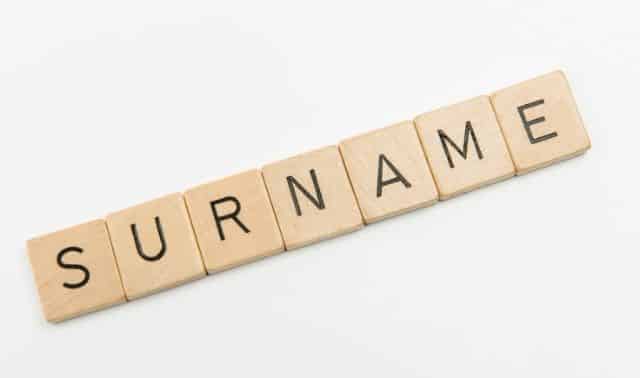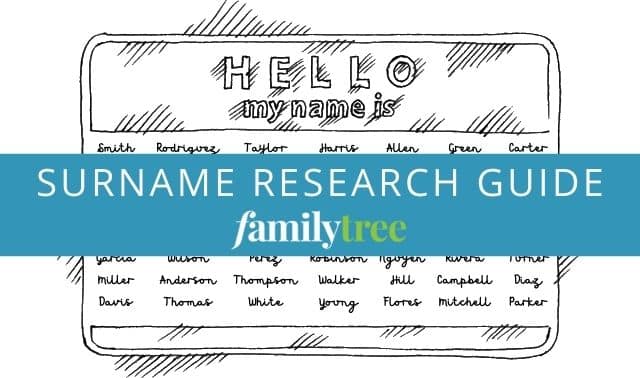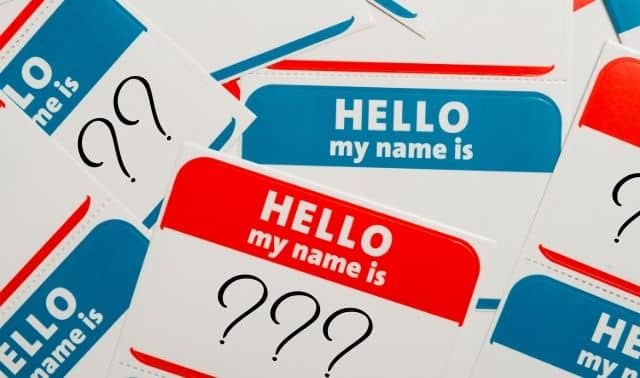“Cruz ka pala? Cruz din yung nanay ko! Magkamag-anak pala tayo!” (“So, your last name’s Cruz? My mom’s maiden name is Cruz, too. We’re related!”)
Believe it or not, the above conversation happens more often than you think, echoed in Cebuano, Kapampangan, Ilokano, Hiligaynon and in the dozens of other languages found in the Philippines. Filipinos usually identify kinship with people who share their last name. Above all else, Filipinos value family the most. There is not one aspect of Filipino life where the family is not a part of. From the most modern cities to the most rural communities, the family always comes first. As already stated in another article on Filipino genealogy, the Philippines is a very family-oriented country and almost every Filipino, whether homegrown or born elsewhere in the world, has the habit of recognizing people as relatives—especially when they share the same family name.
Just to get a feel of how the average Filipino perceives surname and surname usage, a recent survey was conducted among 100 people. In the survey, it was revealed that 9 out of 10 believe in one, some, or all of the following:
- People who have the same family name are related.
- The majority of Filipino surnames are of Spanish origin.
- The majority of Filipinos are of Hispanic extraction because of their surname.
- Most Filipinos have had their surnames since the Spanish colonial period.
- Due to the perceived Hispanicity, many Filipinos also believe they have the legal right to bear the arms associated with their last name.
While many Filipinos today believe that their Spanish-sounding surname is an indication of a Spanish ancestor somewhere up in the family tree, in reality most surnames in the Philippines can be traced back to only 1850, the year the 1849 Claveria Surname Decree was enacted. In the same survey mentioned earlier, 7 out of 10 Filipinos are unfamiliar or have never heard of Narciso Claveria, therefore reinforcing their long-held belief about the origin of their surname.
Evolution and history of Filipino surnames
For some nationalist historians, the use of surnames came not from the Spaniards but existed in pre-colonial times. Perhaps hoping to prove that the Philippines was already at par with the rest of Europe, at least in terms of surname usage and thereby equating surname use as being civilized, some Filipino historians would insist that the indigenous inhabitants of the islands were already with a last name even before being colonized. So, did early Filipinos really have a last name when the Spaniards arrived?

Chinese Filipino surnames
While many historians have already written about the flourishing civilization of pre-colonial period Philippines, there have been very few records and writings available on pre-colonial naming patterns. Author Danilo Madrid Gerona cites in his acclaimed book Ferdinand Magellan: The Armada de Maluco and the European Discovery of the Philippines ancient Chinese texts from the year 1003 that mentioned Butuan’s (a town in the Southern part of the Philippines) ruler’s name as Kiling or Ch’i-ling and that in one tribute mission to China, he was accompanied by a local minister and an assistant whose names were Li-ihan and Gaminan. Gerona also cites Antonio Pigafetta, the Venetian scholar who chronicled Ferdinand Magellan’s voyage, as having mentioned the names of the chiefs and other important personages of the islands they visited: Si Oni, the ruler of the Suluan Island, and the principal men of Suluan namely Inaroyan, Limbas, Bucad, Layong, Calipay, Badiao, Cabuling, and their paramount datu, Garas-Garas.
Also mentioned were Si Oni’s brother, Rajah Kulambo, who was the ruler of Limasawa. When they landed in the island of Sugbu, Pigafetta adds more names of the rulers from the different settlements in and around Sugbu: the paramount ruler of the island, Rajah Humabon and the chiefs Cilaton, Ciguibucan, Cimaningha, Cimatichat, Cicanbul, Apanoaan, Tapan, Simiut, Si Buaia, Sisacai and Maghalibe. And of course, we also add the names of Tupas, who was Humabon’s nephew and heir as well as Cilapulapu, known in history as the first Filipino to defy colonialism through his defeat of Ferdinand Magellan.
Filipino names before Spanish colonization
It is clear from these sampling of names from the earliest rulers of the Visayas that the early, pre-colonial Filipinos did not have a family name. This is concluded by American historian Michael Cullinane in his article “Accounting for Souls: Ecclesiastical Sources for the Study of Philippine Demographic History,” that while there are very few records available on pre-colonial naming patterns, Filipinos did not use family names that were passed from generation to generation. He further cites Pedro Chirino who made an observation during the last decade of the 16th century that “it was common not to use family names or middle names but only one single name, one which was given by the mother”. In fact, no matter how much some would insist, there was nothing unique about the Philippines not having a family name at this point in history. Like other Austronesian settlements and civilizations nearby, most people at that time were known by only one name—their first or given name.
This, naturally, changed when the Spaniards colonized the Philippines. While the earliest parochial records show that the native Filipinos were given just one Christian name during baptism, later records would indicate that the colonized people started mimicking their Spanish colonizers by adopting a second name, although from the late 1500s until most of the early 1700s there were no indications that these second names were being transmitted as a family name.


Using a combination of names
In fact, it can be concluded that prior the the Claveria surname decree, Filipinos were using a combination of names: some had just a single Spanish saint’s name (Jose or Juan or Francisco); some had a single Spanish name and an indigenous descriptive (Maria Alimyon = Mary the beautiful or Jose Ambongan = Jose the good-looking); those with two Spanish saint’s names (Maria Josefa, Agustin Francisco, etc.) which was the most common; those with a Spanish saint’s name and an indigenous second name (Maria Makiling, Juan Macapagal, Rosa Dimataga); those with a Spanish saint’s name and a Spanish patronym (Juan Ponce de Leon, Jose Romualdo); and there were also those with a Spanish saint’s name and a second name comprised of a compressed Chinese personal name, or Filipinized Chinese names (Jose Cojuangco, Pedro Lacson). These samples and many more, however, also tell us that there was at least already an attempt by many families, even those of indio extraction, to carry a second name common to all members in the family, just that there was still no systematic naming system in the entire colony.
This practice of having no formal last names went on until the appointment of a meticulous and able administrator, Don Narciso Claveria y Zaldua, as Governor-General of Las Islas Filipinas in 1844. When he arrived in the islands, it was clear that most inhabitants of the islands were still without formal last names. Being a fastidious and meticulous administrator, he went around the islands to see how the people were doing. One of his most significant contributions as Governor-General was the correction of the Philippine calendar. When the Spaniards first came to the Philippines they based their calendar on Spain’s and in so doing, as they went westward and reached the Philippines, their calendar fell a day behind the rest of the world. So from the time of colonization up until Claveria, the people in the Philippines were actually living the wrong day every day! Claveria, after consulting with the church, decreed that December 30, 1844 (and not December 31) would be immediately followed by January 1, 1845. So in one decree the Philippines finally caught up with the rest of the world’s calendar.
Why do Filipinos have Spanish last names? The Claveria surname decree
Claveria’s most lasting contribution to the Philippines was the surname decree of 1849. In his introduction in the decree, Claveria noted that “during his visit to the provinces of the islands, he observed that the natives in general lacked individual surnames which distinguished them by families, that they arbitrarily adopted the names of saints which resulted in the existence of thousands of individuals having the same “surname”. This resulted then to the confusion in the administration of justice, government, finance, and public order, with far-reaching moral, civil and religious consequences. Because family names were not transmitted from the parents to their children, it was sometimes impossible to prove the degrees of consanguinity for the purpose of marriage, rendering useless the parochial books which in Catholic countries are used for all kinds of transactions.” When the surname decree was enacted in 1849, a list of surnames, called the Catalogo Alfabetico de Apellidos, accompanied it. Inside this catalogue were 60,288 surnames that families had to choose for their use.
Filipino Spanish surnames: True “surnames” not always given
One thing that people rarely bother to know about this list of surnames is that not all the surnames were Spanish. In fact, while roughly 60 to 70% of the listed surnames were Spanish in form, only about 30 to 40% were lifted from a list of actual Spanish surnames. The rest of the listed “surnames” were actually Spanish terms derived from the plant, animal, and mineral kingdoms plus a whole bunch of common, everyday words. The remaining 30 to 40% were comprised of indigenous terms and names, with many of these offensive or downright derogatory (like Baboy = pig, Ung-goy = monkey, Tamboc = obese, and Asuang / Ungo / Ungu = monster). The last 10% were Filipinized Chinese compound names such as Tiapson, Lacson and Jocson.
So aside from families (mostly the ruling elite) who could produce proof of usage of their surname for more than four generations and some other exceptions, it would appear that an approximate 65 to 75% of the population adopted their surname due to the Claveria decree. This thus negates many Filipino families’ long-held lores about the origin of their “Spanish” family name. Common stories include: that their ancestor was actively fighting the Spaniards and in order to avoid prosecution they had to change their name and adopt a Spanish family name; that their ancestor was one of 3 or 5 or even 7 brothers who traveled to the Philippines only to be separated upon arrival in the Philippines, or perhaps having decided to establish their own fortunes in various places in the archipelago yet still keeping their family name. Stories like these abound and are generally accepted as gospel truth by many families, but they are nothing but fairy tales and fanciful legends told by elders to explain the change in family names.
How to check your Filipino surname’s origins
There is a simple way to check if one’s family name is truly an old surname or just a product of the Claveria decree:
1. Check the Catalogo Alfabetico de Apellidos
First, check if your family name or a derivation of it is found in the Catalogo Alfabetico de Apellidos. It is important to check this because it will bring us closer to the truth. For instance, among the 16 presidents of the Philippines, 4 (Osmeña, Laurel, Quirino, and Ramos) were changed during the Claveria decree, while the rest are proven to have been carried by the families prior to the decree, though only one of these, ROXAS, can be proven to have come from Spain by way of Mexico. The rest were most likely adopted from the mid-1600s to the 1700s and carried for generations, thus allowing for the continued transmission of these names.
2. Try variations for your last name
Many would also say that their surname is not listed in the Catalogo. In fact, many surnames today are misspelling or variations of names from the Catalogo. So if you think your last name is not in the list, try variations of it. For instance, the surname Davide is not found in the list but David is. Osmeña is not found but Esmeña is. Other variations include surnames starting in “B” as having been originally spelled with a “V”, “D” as being “R” before, or last names ending with an “a” originally ending with an “o” or vice-versa. Other misspellings include single letters instead of double, “I” to “E”, “S” to “Z”, and “J” to “H”. The catalogo, then, is simply a first step, but finding one’s last name there, or not finding it, is simply inconclusive.
3. Check the records in your hometown
The next step in checking whether your last name is a product of the Claveria decree is to check the records of your family’s hometown. A good place to start is through FamilySearch’s records section. It has catalogued millions of records although access to the actual archival document (which is allowed in other countries) is currently on hold due to the Philippines’s Data Privacy Act. The only other option is to visit your local parish and see if records are available. The safest range is between 1845 to 1855 so one can compare the recorded last names before and after the decree. For those with ancestry coming from Ilocos Sur or Ilocos Norte, records from these provinces show the adopted name and the old last name in records after 1849. This is a sure way to know if one’s family name was changed or not due to the decree.

4. Consider a genetic genealogy test
Finally, having discovered that one’s last name was available and used prior to 1849 is still not a guarantee that one’s surname is truly Hispanic. The only way to prove this is to do a genetic genealogy test. Autosomal DNA test is okay, but to be very specific a Y-DNA test will yield a more accurate result. This will, once and for all, prove or disprove the belief of many Filipinos of being descended from Spaniards (or other Europeans). The thing is, the Spaniards never fully intermarried with the natives in the Philippines as they did in Mexico, Venezuela, and their other former colonies. And, according to verifiable archival documents, more than 90% of each town’s population were described as indio (or native Filipino) in most church records for most of the 333 years the Spaniards colonized the Philippines.
Implications of the Decree to Filipino Genealogy
The implications of the Claveria decree are quite far-reaching. For one thing, even if your research shows that your family has had the family name before Claveria’s decree, if it is found in the Catalogo this means you cannot be sure that all people carrying your surname are related, because finding it in the list of last names means others certainly would have adopted it because of the decree. Therefore, one must not assume that one is related to someone just because they share a last name.
Filipino surnames and heraldry
Second, the fact that you carry a Spanish last name means very little, and certainly does not mean you have Spanish ancestry. The family name is not always proof of having European heritage. Therefore, also, we go to another implication of the Claveria decree. Since we cannot always prove descent from a Spanish ancestor based solely on the surname we carry, we also cannot claim the usage of established coats-of-arms. As we know, heraldry, which is the practice of designing, displaying, describing, and recording coats of arms and badges, is an important auxiliary to genealogy. Historically, coats-of-arms were used to distinguish the armies of one knight against another. Later on, these colorful banners were incorporated into family decorations and when these were already common practice, state authorities started regulating the use of arms. Technically, a coat-of-arms is granted to a person, and not a family, though in most countries with traditions of heraldry other members of the family can use a “differenced” version of the arms.
In the Philippines, family reunions usually have souvenir programs and t-shirts prepared for everyone with colorful illustrations of coats-of-arms emblazoned on them. There are hundreds of sites where one can just search for arms related to a family name. While there is no law against the use of these arms in the Philippines, Claveria’s surname decree clearly disproves the right of many of these families to bear these arms. Some have even gone to Spain to get copies of their arms from institutions like the Real Academia de la Historia in Madrid and think that because they were able to get it from Spain then they have the right to use them. Sadly, this is not true. And certainly, even having a Spanish grandfather or even a great-great-grandfather with archival documentation does not automatically mean that this ancestor was granted the right to bear arms. This becomes especially true when an ancestor carries a very common last name, like GARCIA, CRUZ, PEREZ, etc. So always check first with the authorities if your last name is originally Spanish, and if your Spanish ancestor was granted the right to bear arms.
While the Philippines has a Heraldic Code, the focus of this law is on governmental arms and not so much on personal or familial arms. So far, the Philippine Armorial group is the only group of enthusiasts who advocate for the promotion of heraldry in the Philippines, using coats-of-arms designed and assumed by the bearers. They encourage and inspire more Filipinos to adopt their own coats of arms.
The effect of the decree on family history
While the Claveria decree would disprove many Filipino families’ long-held, almost sacred oral traditions about their history, the decree made the Philippines one of the first (outside mainland Europe and China) to formally legislate the formal use of surnames. Japan came later in 1875, Thailand in 1913, Tunisia in 1925, Turkey in 1926, and Iran in 1932.
Many families would later discover that, because of Claveria’s decree, the old stories told to them by their elders are, unfortunately, not accurate, such as being descendants of foreigners, having foreign blood, coming to the Philippines with Magellan, and so on. In the long run, one’s bloodline matters little. What is important is the tracing, preservation, and transmission of these histories so future Filipinos and their descendants will have an idea as to where they have been, and where they are headed.
For more discussion and a complete list of the surnames in Claveria’s decree, check out The Catalogo, Narciso Claveria, and Thoughts on Filipino Surnames.
Related Reads
FamilyTreeMagazine.com is a participant in the Amazon Associates Program, an affiliate advertising program. It provides a means for this site to earn advertising fees, by advertising and linking to Amazon and affiliated websites.












